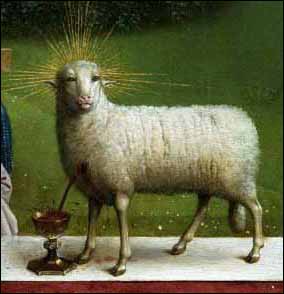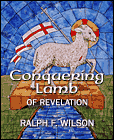
|
Old Testament
New Testament
Gospels
Acts
Paul's Letters
General Letters
Revelation
Topical Studies
Beginning the Journey (for new Christians). en Español

|
Old Testament
New Testament
Gospels
Acts
Paul's Letters
General Letters
Revelation
Topical Studies

|
Home
Bible Studies
Articles
Books
Podcasts
Search
Menu
Donate
About Us
Contact Us
FAQ
Sitemap
Day 3. The Lamb Who Is Slain (Revelation 5:6)
 Detail. Adoration of the Lamb, by Jan van Eyck (1432), oil on wood, Ghent altarpiece, Cathedral of St. Bavo, Ghent. |
We're examining the Lamb in God's throne room. The Lion of Judah who conquers is the Lamb who is slain. But as John describes what he sees in the throne room of God, this Lamb is not lying lifeless on the ground, drained of blood, dead. No, he is standing next to the throne. Standing!
"And between the throne and the four living creatures and among the elders I saw a Lamb standing, as though it had been slain, with seven horns and with seven eyes, which are the seven spirits of God sent out into all the earth." (Revelation 5:6)
Picturing the Lamb
Let's explore what this picture of the Lamb says to us.
1. The Lamb is standing. The verb histēmi, "stand," can be used in lots of ways -- "stand up, stand still, appear before," etc. -- but it doesn't mean to lie down. If the Lamb were dead he would be lying. His position of standing indicates that he is alive -- and we know that this is because God raised him from the dead! The Lamb is standing in the victory of resurrection.
2. The Lamb has been slain, that is, "slaughtered, butchered."4 We look at this standing Lamb as one who has been slain.5 Interestingly, both the Greek participles "standing" and "slain" are in the perfect tense, indicating an established action in the past that continues to the present -- still slain, still standing as a conqueror. Of course, standing and having been slain are a grand paradox (more on this on Day 5).
3. The Lamb is at the throne. The Lamb is standing at or near the throne, symbolizing his royal status and power.6
4. The Lamb has seven horns. When you try to picture a lamb with seven horns, it looks bizarre. When you understand it as a symbol, then it makes sense. The Hebrews were a shepherd-people, so it was natural that the ram's horn would come to symbolize strength. In Hebraic thought, then, a horn is a symbol of strength, power, and military might.
The number seven was considered a sacred number in virtually all ancient Semitic cultures. In the Bible it is especially important, appearing almost 600 times, often bearing the idea of fullness or completeness. Thus seven horns indicate complete, full power. The Lamb possesses unrivaled power, omnipotence.
5. The Lamb has seven eyes. The eye signifies seeing and perception, so seven eyes indicate all-seeing, all-knowing, omniscience. We're told that the eyes "are the seven spirits of God sent out into all the earth." So the "seven spirits" will mean the full power of the Holy Spirit abroad on earth on Christ's behalf.
The Lamb Is Slain, but Not Dead
The Lamb has been slain, taking our sins upon himself. But he is not dead. He is alive, standing triumphant, conquering beside the throne of God, all-powerful, all-seeing, exercising the full power of the Holy Spirit.
This depiction of conquering in spite of suffering is designed to encourage the persecuted and suffering church, one of the main purposes of the Book of Revelation.
You may be persecuted for your faith. You may be suffering in other ways. Your Savior is the Lamb of God, who still bears the marks of his suffering, but is standing -- raised from the dead triumphant. Don't despair!
 Available in PDF, and Kindle formats, |
As the writer of Hebrews puts it, we who are running the race are constantly ...
"Looking to Jesus, the founder and perfecter of
our faith,
who for the joy that was set before him
endured the cross, despising the shame,
and is seated at the right hand of the throne of God." (Hebrews 12:2)
My friend, find your encouragement today looking to the conquering Lamb, slain for you, yet standing triumphant!
Prayer
Lord Jesus, Lamb of God, we look to You today. We bring to you our hurts, struggles, and sufferings, knowing that you understand. And we bring them to you knowing that you are all-powerful. Hallelujah! We trust you to be our Refuge and Help today. In your holy name, we pray. Amen.
Day 3 Meditation (Revelation 5:6). How is the Lamb
described in verse 6? What does that tell you about his ability to help you now,
in your present circumstances? Considering the standing Lamb that was slain, how
do the wounds you have experienced become your strengths?
https://www.joyfulheart.com/forums/topic/1877-day-3-slain/
Endnotes
(References and Abbreviations)
[6] The adjective mesos, "in the middle of, among," used twice in verse 6, is variously translated, "between the throne and the four living creatures" (ESV, NRSV, NASB), "in the center of the throne" (NIV), "in the midst of the throne" (KJV), "in the middle of the throne" (NJB), etc. Danker sees this verse as "in the center of the throne and among the four living creatures" (BDAG 635, 1b). My guess is that John didn't plan on us trying analyze the Lamb's exact position in relation to the throne (Beale, Revelation, p. 350). However, it seems that the Lamb is positioned near the throne of God, not in it or on it, since in verse 7 he approaches the throne to receive the scroll.
Copyright © 2025, Ralph F. Wilson. <pastor![]() joyfulheart.com> All rights reserved. A single copy of this article is free. Do not put this on a website. See legal, copyright, and reprint information.
joyfulheart.com> All rights reserved. A single copy of this article is free. Do not put this on a website. See legal, copyright, and reprint information.

